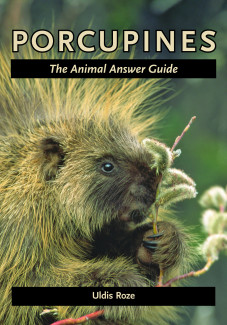
Johns Hopkins UniversityEst. 1876
America’s First Research University
Wild Thing: How do quills work?
Wild Thing is an occasional series where JHU Press authors write about the flora and fauna of the natural world—from the rarest flower to the most magnificent beast.
Guest post by Uldis Roze
Having grown up in large cities where porcupines are absent, I was in my 30s before I saw my first porcupine in the wild. We met at night, in the light cone of my flashlight, as the porcupine was chewing our freshly-built cabin at a woods edge in the Catskills. The animal looked surreal and wild, but I had no doubt about its identification. It had quills, therefore it was a porcupine.
But the quills that give porcupines their easy identification and shape their natural histories are themselves the source of endless mystery and mystification.
Do porcupines throw their quills? All scientific accounts assure readers to the contrary, but it wasn’t always so. Writing in the April 16, 1956 issue of Sports Illustrated, Dr. William J. Lang describes a porcupine he had surprised in a woodshed: “With an upward flick of his tail, one quill grazed my cheek, another stuck in my hat brim . . . three more clung by their barbed tips to the cedar splits.” Dr. Lang notwithstanding, porcupines can no more throw their quills than dogs can throw their hair, and if they somehow evolved the capacity to do so, it would do the throwers no good. This is for reasons of fundamental physics: the energy residing in a moving body is given by its momentum, the product of its mass times velocity. Because a porcupine quill has negligible mass, it would carry negligible momentum, and serve very poorly in the animal’s defense.

A porcupine misunderstood. The royal crest of Louis XII of France featured a crested porcupine, shown throwing a shower of quills at distant enemies, while keeping other quills in reserve for an impregnable defense. Perhaps because Louis XII lost most of his military engagements, his successors abandoned the porcupine symbolism. Photo by Philippa Moore.
Perhaps the flying quill hypothesis is so persistent because when quills arrive in human skin, they materialize in a microsecond, faster than the eye can follow. But quills do not arrive in flight--they arrive on the surface of the tail. And because the mass of the incoming is not the mass of the quill alone but the mass of the quill plus tail, the momentum is high and the quill can penetrate deeply.
Another source of quill confusion is the one-way barbs. True or false: all porcupine quills have barbed tips. False!
No Old-World porcupine (11 spp.) carries barbed quills. With a single exception, all New-World porcupines (15 spp.) carry barbed quills. The presence or absence of barbs is possibly the most fundamental difference between quills of the 2 porcupine families.
Old-World porcupines are large animals, with some species reaching weights of 50 lbs in the wild. They are defended by large quills with sharp, knife-like tips that can kill lions and leopards. Large quills require large bodies for delivery. But large bodies are not an option for New-World porcupines, who live in trees. Their small bodies carry small quills. With the evolutionary invention of barbs, these small quills can travel deep inside a predator’s body, pulled by the predator’s own muscles until they either strike an organ or exit the body, far from the point of entry.
That said, there are limits to the defense offered by small quills. Unlike their Old-World cousins, who can stand up to the large cats of Africa and Asia, New-World porcupines have no effective defense against their North American predator, the mountain lion. Rick Sweitzer, who studied a porcupine population in the Great Basin desert of Nevada, reports what happened when a single mountain lion started preying on his porcupines. In a 3-year period, the population plummeted from 82 animals to just 5. Instead of avoiding the quills, mountain lions eat their porcupines whole, and accept the consequences. Mountain lions autopsied in Oregon routinely showed quill tips embedded in the gums, where they had come to rest against the jawbone.
How many quills does a North American porcupine carry? An answer given by one respondent is “roughly 658, but I lost count after they kept stabbing me." A more common answer is “around 30,000." The number, enshrined in the biological literature, seems to make sense because hundreds of quills may be lost with each predator attack, and lost quills require months to replace. Therefore carrying a hundred-fold excess represents an effective safety (pin)cushion.
But the source of the 30,000 quill figure cannot be found. The earliest mention of the number is by Donald Spencer in 1950, in a National Geographic article. Spencer gives no indication that he counted the quills himself, nor identifies the source who did.
Much else about porcupine quills remains unknown or misunderstood. Quills of North American porcupines carry surface antibiotics, and help disseminate a warning odor. Do other porcupine species show the same capabilities? We don’t know and can’t predict, because North American porcupines follow a unique life style, even within its New-World family. Shouldn’t we approach porcupines with the same openness we extend to our wives, husbands, lovers: work to know them as they are, not as we perceived them on first meeting?



